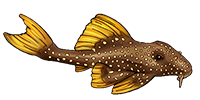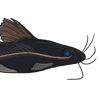Benthic suction feeding in Callichthyidae and Mochokidae
- Silurus
- Posts: 12460
- Joined: 31 Dec 2002, 11:35
- I've donated: $12.00!
- My articles: 55
- My images: 896
- My catfish: 1
- My cats species list: 90 (i:1, k:0)
- Spotted: 428
- Location 1: Singapore
- Location 2: Moderator Emeritus
Benthic suction feeding in Callichthyidae and Mochokidae
Van Wassenbergh, S, T Lieben, A Herrel, F Huysentruyt, T Geerinckx, D Adriaens & P Aerts, 2009. Kinematics of benthic suction feeding in Callichthyidae and Mochokidae, with functional implications for the evolution of food scraping in catfishes. Journal of Experimental Biology 212: 116–125.
Abstract
Food scraping has independently evolved twice from suction feeding in the evolution of catfishes: within neotropical Loricarioidea and paleotropical Mochokidae. To gain insight in the evolutionary transitions associated with the evolution towards scraping, we analyzed prey capture kinematics in two species of benthic suction feeders which belong to taxa that are closely related to the scraper lineages (respectively, Corydoras splendens and Synodontis multipunctatus), and compared it to prey capture in a more distantly related, generalist suction feeder (Clarias gariepinus). Simultaneous ventral and lateral view highspeed videos were recorded to quantify the movements of the lower jaw, hyoid, pectoral girdle and neurocranium. Additionally, ellipse modeling was applied to relate head shape differences to buccal expansion kinematics. Similarly to what has been observed in scrapers, rotations of the neurocranium are minimal in the benthic suction feeders, and may consequently have facilitated the evolution of a scraping feeding mechanism. The hypothesis that fish with a more laterally compressed head rely more heavily on lateral expansion of the buccal cavity to generate suction, was confirmed in our sample of catfish species. Since an important contribution of lateral expansion of the head to suction may avoid the need for a strong, ventral depression of the mouth floor during feeding, we hypothesized that this may have allowed a closer association with the substrate in the ancestors of scrapers. However, our hypothesis was not supported by an ancestral state reconstruction, which suggests that scraping probably evolved from sub-terminal mouthed ancestors with dorsoventrally flattened heads.
Abstract
Food scraping has independently evolved twice from suction feeding in the evolution of catfishes: within neotropical Loricarioidea and paleotropical Mochokidae. To gain insight in the evolutionary transitions associated with the evolution towards scraping, we analyzed prey capture kinematics in two species of benthic suction feeders which belong to taxa that are closely related to the scraper lineages (respectively, Corydoras splendens and Synodontis multipunctatus), and compared it to prey capture in a more distantly related, generalist suction feeder (Clarias gariepinus). Simultaneous ventral and lateral view highspeed videos were recorded to quantify the movements of the lower jaw, hyoid, pectoral girdle and neurocranium. Additionally, ellipse modeling was applied to relate head shape differences to buccal expansion kinematics. Similarly to what has been observed in scrapers, rotations of the neurocranium are minimal in the benthic suction feeders, and may consequently have facilitated the evolution of a scraping feeding mechanism. The hypothesis that fish with a more laterally compressed head rely more heavily on lateral expansion of the buccal cavity to generate suction, was confirmed in our sample of catfish species. Since an important contribution of lateral expansion of the head to suction may avoid the need for a strong, ventral depression of the mouth floor during feeding, we hypothesized that this may have allowed a closer association with the substrate in the ancestors of scrapers. However, our hypothesis was not supported by an ancestral state reconstruction, which suggests that scraping probably evolved from sub-terminal mouthed ancestors with dorsoventrally flattened heads.

- Silurus
- Posts: 12460
- Joined: 31 Dec 2002, 11:35
- I've donated: $12.00!
- My articles: 55
- My images: 896
- My catfish: 1
- My cats species list: 90 (i:1, k:0)
- Spotted: 428
- Location 1: Singapore
- Location 2: Moderator Emeritus
Re: Benthic suction feeding in Callichthyidae and Mochokidae
This is the first paper I have seen that uses Corydoras splendens.

- MatsP
- Posts: 21038
- Joined: 06 Oct 2004, 13:58
- My articles: 4
- My images: 28
- My cats species list: 117 (i:33, k:0)
- My aquaria list: 10 (i:8)
- My BLogs: 4 (i:0, p:164)
- Spotted: 187
- Location 1: North of Cambridge
- Location 2: England.
Re: Benthic suction feeding in Callichthyidae and Mochokidae
That is interesting - one wonders if that is intentional to indicate that they see Brochis and Corydoras as the same species [I presume it is what we call B. splendens that they ARE referring to].Silurus wrote:This is the first paper I have seen that uses Corydoras splendens.
[the article itself appears to be quite interesting too - you don't happen to have a PDF, do you?]
--
Mats
- Silurus
- Posts: 12460
- Joined: 31 Dec 2002, 11:35
- I've donated: $12.00!
- My articles: 55
- My images: 896
- My catfish: 1
- My cats species list: 90 (i:1, k:0)
- Spotted: 428
- Location 1: Singapore
- Location 2: Moderator Emeritus
Re: Benthic suction feeding in Callichthyidae and Mochokidae
The synonymy of Brochis with Corydoras dates from here, but I have not seen it in the scientific literature until now.

- MatsP
- Posts: 21038
- Joined: 06 Oct 2004, 13:58
- My articles: 4
- My images: 28
- My cats species list: 117 (i:33, k:0)
- My aquaria list: 10 (i:8)
- My BLogs: 4 (i:0, p:164)
- Spotted: 187
- Location 1: North of Cambridge
- Location 2: England.
Re: Benthic suction feeding in Callichthyidae and Mochokidae
Ah, ok - I vaguely remember that discussion.Silurus wrote:The synonymy of Brochis with Corydoras dates from here, but I have not seen it in the scientific literature until now.
--
Mats
-
lfinley58
- Expert
- Posts: 725
- Joined: 04 Jan 2003, 19:16
- I've donated: $90.00!
- My articles: 3
- My images: 3
- Spotted: 3
- Location 1: Margate
- Location 2: Florida USA
- Interests: Catfishes (all), Aquarium History
Brochis = Corydoras in scientific lit
Hi all.
Ferraris placed the three Brochis species in the genus Corydoras in his 2007 checklist. This should fit well enough as an earlier presentation in the scientific literature.
Lee
Ferraris placed the three Brochis species in the genus Corydoras in his 2007 checklist. This should fit well enough as an earlier presentation in the scientific literature.
Lee
-
lfinley58
- Expert
- Posts: 725
- Joined: 04 Jan 2003, 19:16
- I've donated: $90.00!
- My articles: 3
- My images: 3
- Spotted: 3
- Location 1: Margate
- Location 2: Florida USA
- Interests: Catfishes (all), Aquarium History
PDF available at.....
Hi all. A PDF of the paper is available at: http://webh01.ua.ac.be/funmorph/publica ... p_Biol.pdf
Lee
Lee
- Carp37
- Posts: 596
- Joined: 21 Sep 2007, 13:08
- My cats species list: 16 (i:7, k:0)
- My aquaria list: 7 (i:6)
- My BLogs: 2 (i:0, p:51)
- Location 2: Aughton UK
- Interests: fish, fishing, fossils, evolution/taxonomy, films
Re: Benthic suction feeding in Callichthyidae and Mochokidae
I notice the paper refers to Callichthys barbatus for one of the figures- I'm assuming this is a mistake as it certainly looks more like a Scleromystax line drawing than a Callichthys one?
Megalechis thoracata, Callichthys callichthys, Brochis splendens (and progeny), Corydoras sterbai, C. weitzmani, CW044 cf. pestai, CW021 cf. axelrodi, Pterygoplichthys gibbiceps, Ancistrus cf. cirrhosus (and progeny), Panaque maccus, Panaque nigrolineatus, Synodontis eupterus
- MatsP
- Posts: 21038
- Joined: 06 Oct 2004, 13:58
- My articles: 4
- My images: 28
- My cats species list: 117 (i:33, k:0)
- My aquaria list: 10 (i:8)
- My BLogs: 4 (i:0, p:164)
- Spotted: 187
- Location 1: North of Cambridge
- Location 2: England.
Re: Benthic suction feeding in Callichthyidae and Mochokidae
I saw that too - which makes one wonder if the "brochis == corydoras" is actually just a mistake, or if it's intentional.Carp37 wrote:I notice the paper refers to Callichthys barbatus for one of the figures- I'm assuming this is a mistake as it certainly looks more like a Scleromystax line drawing than a Callichthys one?
--
Mats




